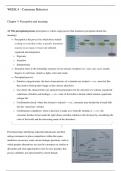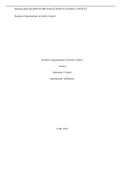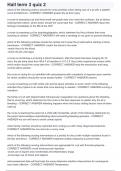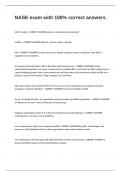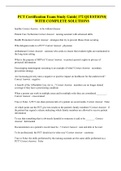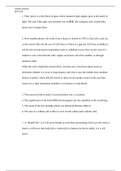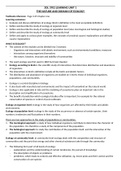WEEK 4 - Consumer Behavior
Chapter 3- Perception and meaning
3.1 The perceptual process (perception is a three-stage process that translates perceptual stimuli into
meaning)
→ Perception is the process by which these stimuli
(a thing or event that evokes a specific functional
reaction in an organ or tissue) are selected,
organized and interpreted.
o Exposure
o Attention
o Interpretation
→ Sensation refers to the immediate response of our semsory receptors (ex.: eyes, ears, nose, mouth,
fingers) to such basic stimuli as light, color and sound.
→ Perceptual process:
o Primitive categorisation: the basic characteristics of a stimulus are isolated --» ex.: men feel like
they need to hold up their image so they choose aftershave
o Cue check: the characteristics are analysed in preparation for the selection of a schema (organized
collections of beliefs and feelings) --» ex.: color of the bottle to decide which schema a particular
cologne fits
o Confirmation check: where the schema is selected --» ex.: consumer may decidet hat a brand falls
into his ’myterious’ schema
o Confirmation completion: where a decision is made as to what the stimulus is --» ex.: the
consumer decides he has made the right choice and then reinforces this decision by considering the
color of the bottle and the interesting name of the aftershave
Perceptual map: identifying important dimensions and then
asking consumers to place competitiors within this space,
marketers can answer some curcial strategic questions, such as
which product alternatives are seen by consumer sas similar or
dissimilar and what opportunities exist for new produtcs that
possess attributes not represented by current brands.
,3.2 Sensory systems (all our sensory systems are adressed through marketing)
→ Sensory marketing: companies pay extra attention to the impact of senations on our product
experiences --» because our senses help us to decide which products appeal to us
→ Hedonic consumption: focuses on comsumer behaviour which seeks sensory pleasures or hedonistic
benefits provided by interaction with good or services.
→ Computer-stimulates enviroment/ virtual reality: it creates a 3D perceptual enviroment that the
viewer experiences as being virtually real --» for ex.: virtual reality games, it allows surgeons to ’cut
into’ a person without drawing blood or an architect to see a building design from different
perspectives.
i. Vision
Marketers rely heavily on visual elements in advertising, store design and packaging --» they
communicate meaning on the visual channel through a product’s color, size and sytling
ii. Smell
Odours can stir emotions or create calming feeling --» they can evoke memories or relieve
stress
The fragrance market is extremely competitive and expensive
iii. Sound
Music and other sounds affect people’s feelings and behaviour
Some marketers who come up with brand names pay attention to sound symbolism --» the
process by which the way a word sounds influences our assumptions about what it describes
and attributes such as size.
iv. Touch
Researchers found that participants who simply touched an item for 30 seconds ro less
created a greater level of attachment to the product
We have a tendency to want to touch objects --» habitual human movement
v. Taste
Our taste receptiors contribute to our experience of many products
Sensory analysis is used to account for the human perception of sensory qualities
Food companies go to great lengths to ensure that their products taste as they should
3.3 Perceptual selection (the concept of a perceptual selection is important for marketing communication)
→ Sensory thresholds: the science that focuses on how the physical enviroment is integrated into our
personal, subjective world is known as osychophysics.
→ The absolute threshold refers to the minimus anount of stimulation that can be detected on a sensory
channel --» it is an important consideration in designing marketing stimuli
, → The differential threshold refers to the ability of a sensory system to detect changes or differences
between two stimuli
o JND (’just-noticeable difference’) --» the minimum change in a stimulus that can be detected
o Weber’s Law --» the stronger the initial stimulus, the greater the change must be for it to be
noticed
→ Augmented reality refers to media that combine a physical layer with a digital layer to create a
combined experience (for ex.: watching a movie in 3D)
o Web-based AR --» these techniques use your PC and webcam to offer an enhanced experience,
often via a marker, image or through motion capture (for ex.: Fashionista dressing-room app)
o Kiosk-based AR --» similar to web-based AR but can often find more powerful applications tat use
3D or facial tracking
o Mobile AR --» these apps use the viewfinder on a mobile phone to access enhanced digital
information
→ Attention is the defree to which consumers focus on stimuli within their range of exposure
(consumers are often in a state of sensory overload)
o Multitasking and attention --» to process information from more than one medium at the same
time. The brain’s capacity to process information is limited, ocnsumers are very selective about
what they pay attention to --» the process of perceptual selection means that people attend to only a
small portion of the stimuli to ehich they are exposed to
o Personal selection factors
- Perceptual vigilance: consumers are more likely to be aware of stimuli that relate to their
current needs
- Perceptual defence: people see what they want to see and don’t see what they don’t want to see
- Adaptation: the degree to which consumers continue to notice a stimulus over time--» it occurs
when consumers no longer pay attention to a stimulus because it is so familiar
o Stimulus selection factors
- Size: the size of the stimulus itself helps to determine if it will command attention
- Color: powerful way to draw attention to a product or to give a distinct identity
- Position: there is a better chance of noticing stimuli that are in places we are more likely to look
- Novelty: stimuli that appear in unexpected ways or places tend to grab our attention
→ Interpretation: deciding what things mean --» refers to the meanings we assign to sensory stimuli
- Stimulus organization --» the gestalt --» these principles are based on work in gestalt
psychology (a school of thought maintaining that people derive meaning from the totality of a
set of stimuli, rather than from any individual stimulus. [gestalt=’whole’, ’pattern’,
configuration’]
• The gestalt principle of closure: consumers tend to percieve an incomplete picture as
complete
Chapter 3- Perception and meaning
3.1 The perceptual process (perception is a three-stage process that translates perceptual stimuli into
meaning)
→ Perception is the process by which these stimuli
(a thing or event that evokes a specific functional
reaction in an organ or tissue) are selected,
organized and interpreted.
o Exposure
o Attention
o Interpretation
→ Sensation refers to the immediate response of our semsory receptors (ex.: eyes, ears, nose, mouth,
fingers) to such basic stimuli as light, color and sound.
→ Perceptual process:
o Primitive categorisation: the basic characteristics of a stimulus are isolated --» ex.: men feel like
they need to hold up their image so they choose aftershave
o Cue check: the characteristics are analysed in preparation for the selection of a schema (organized
collections of beliefs and feelings) --» ex.: color of the bottle to decide which schema a particular
cologne fits
o Confirmation check: where the schema is selected --» ex.: consumer may decidet hat a brand falls
into his ’myterious’ schema
o Confirmation completion: where a decision is made as to what the stimulus is --» ex.: the
consumer decides he has made the right choice and then reinforces this decision by considering the
color of the bottle and the interesting name of the aftershave
Perceptual map: identifying important dimensions and then
asking consumers to place competitiors within this space,
marketers can answer some curcial strategic questions, such as
which product alternatives are seen by consumer sas similar or
dissimilar and what opportunities exist for new produtcs that
possess attributes not represented by current brands.
,3.2 Sensory systems (all our sensory systems are adressed through marketing)
→ Sensory marketing: companies pay extra attention to the impact of senations on our product
experiences --» because our senses help us to decide which products appeal to us
→ Hedonic consumption: focuses on comsumer behaviour which seeks sensory pleasures or hedonistic
benefits provided by interaction with good or services.
→ Computer-stimulates enviroment/ virtual reality: it creates a 3D perceptual enviroment that the
viewer experiences as being virtually real --» for ex.: virtual reality games, it allows surgeons to ’cut
into’ a person without drawing blood or an architect to see a building design from different
perspectives.
i. Vision
Marketers rely heavily on visual elements in advertising, store design and packaging --» they
communicate meaning on the visual channel through a product’s color, size and sytling
ii. Smell
Odours can stir emotions or create calming feeling --» they can evoke memories or relieve
stress
The fragrance market is extremely competitive and expensive
iii. Sound
Music and other sounds affect people’s feelings and behaviour
Some marketers who come up with brand names pay attention to sound symbolism --» the
process by which the way a word sounds influences our assumptions about what it describes
and attributes such as size.
iv. Touch
Researchers found that participants who simply touched an item for 30 seconds ro less
created a greater level of attachment to the product
We have a tendency to want to touch objects --» habitual human movement
v. Taste
Our taste receptiors contribute to our experience of many products
Sensory analysis is used to account for the human perception of sensory qualities
Food companies go to great lengths to ensure that their products taste as they should
3.3 Perceptual selection (the concept of a perceptual selection is important for marketing communication)
→ Sensory thresholds: the science that focuses on how the physical enviroment is integrated into our
personal, subjective world is known as osychophysics.
→ The absolute threshold refers to the minimus anount of stimulation that can be detected on a sensory
channel --» it is an important consideration in designing marketing stimuli
, → The differential threshold refers to the ability of a sensory system to detect changes or differences
between two stimuli
o JND (’just-noticeable difference’) --» the minimum change in a stimulus that can be detected
o Weber’s Law --» the stronger the initial stimulus, the greater the change must be for it to be
noticed
→ Augmented reality refers to media that combine a physical layer with a digital layer to create a
combined experience (for ex.: watching a movie in 3D)
o Web-based AR --» these techniques use your PC and webcam to offer an enhanced experience,
often via a marker, image or through motion capture (for ex.: Fashionista dressing-room app)
o Kiosk-based AR --» similar to web-based AR but can often find more powerful applications tat use
3D or facial tracking
o Mobile AR --» these apps use the viewfinder on a mobile phone to access enhanced digital
information
→ Attention is the defree to which consumers focus on stimuli within their range of exposure
(consumers are often in a state of sensory overload)
o Multitasking and attention --» to process information from more than one medium at the same
time. The brain’s capacity to process information is limited, ocnsumers are very selective about
what they pay attention to --» the process of perceptual selection means that people attend to only a
small portion of the stimuli to ehich they are exposed to
o Personal selection factors
- Perceptual vigilance: consumers are more likely to be aware of stimuli that relate to their
current needs
- Perceptual defence: people see what they want to see and don’t see what they don’t want to see
- Adaptation: the degree to which consumers continue to notice a stimulus over time--» it occurs
when consumers no longer pay attention to a stimulus because it is so familiar
o Stimulus selection factors
- Size: the size of the stimulus itself helps to determine if it will command attention
- Color: powerful way to draw attention to a product or to give a distinct identity
- Position: there is a better chance of noticing stimuli that are in places we are more likely to look
- Novelty: stimuli that appear in unexpected ways or places tend to grab our attention
→ Interpretation: deciding what things mean --» refers to the meanings we assign to sensory stimuli
- Stimulus organization --» the gestalt --» these principles are based on work in gestalt
psychology (a school of thought maintaining that people derive meaning from the totality of a
set of stimuli, rather than from any individual stimulus. [gestalt=’whole’, ’pattern’,
configuration’]
• The gestalt principle of closure: consumers tend to percieve an incomplete picture as
complete


